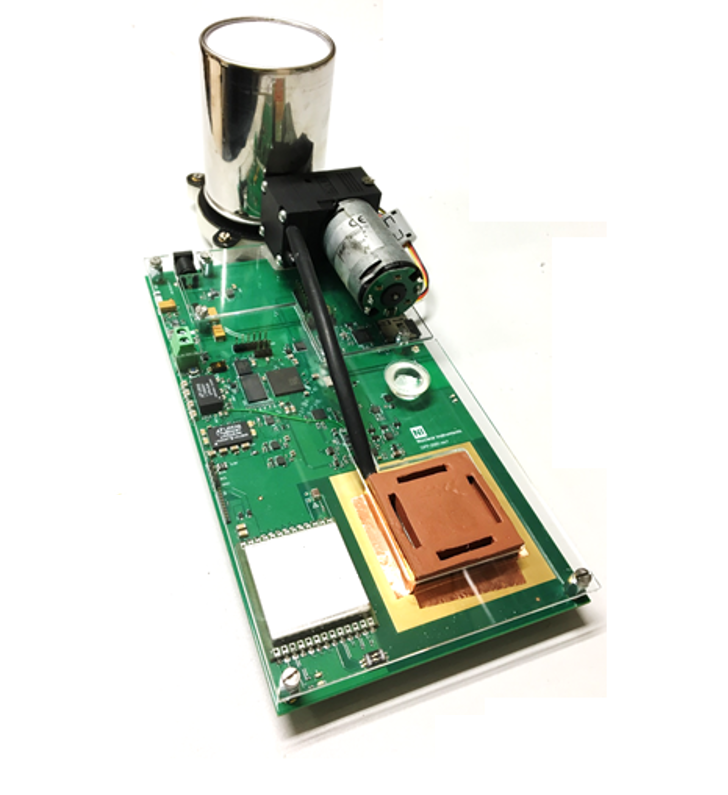
Developing solutions for better air quality with AIDA-2020
Alessandro Curioni (CERN), 28/04/2020

Prototype of the innovative radon monitoring device RaDoM (Image: BAQ).
My interest in radon started in 2013, when I started working for the CERN Radiation Protection Group in the Special Projects section, coordinated by Marco Silari, today a member of my company BAQ’s Advisory Board. BAQ stands for Better Air Quality. At the time, a PhD student was developing a radon detector: it was not the most practical design, but it raised the topic of the radon problem within the team.
Radon is a natural radioactive gas resulting from the decay of uranium, a naturally occurring element in soil and rocks. A significant radon concentration can also be found in spring waters and ground water. As a noble gas, radon easily escapes from the soil and water, and accumulates in dwellings and buildings. The progeny from radon decay is radioactive and it might adhere to dust and particulates in the air.
When inhaled, this radioactive particulate settles in the lungs. Epidemiological studies have shown a clear correlation between radon exposure and the incidence of lung cancer. In fact, radon is the second leading cause of lung cancer after smoking, being directly linked to more than 200’000 cases of lung cancer worldwide.
We fast-forward to 2016. At that point, a new PhD student (Stefano Romano, today Chief Technology Officer at BAQ) had already spent two years working on a new radon detector. This new device was specifically designed to give a more precise estimate of the radioactive dose deposited in the lungs. At the time, Stefano came up with a rather solid idea for the exploitation of this sensor in radiation monitoring in day-to-day life.
Within the CERN Radiation Protection “Special Projects” section, we started looking for funding opportunities to build a prototype for a commercially viable instrument, which we could later transfer to a company interested in making this technology commercially available. The Radon Dose Monitor (RaDoM) project was funded both by the AIDA-2020 Proof-of-Concept (PoC) and by the CERN MAPF (Medical Applications Project Forum). Work in the project started in earnest in 2017.
With this new funding, the RaDoM team, with help from Politecnico di Milano and MIAM (an Italian company), worked to develop a practical radon dosimeter and – in parallel – a data network of smart sensors for monitoring radon. The outcome of this work will help to meet the challenge of the recent EU Directive 2013/59/Euratom, which defines the new, more careful and more restrictive approach in tackling the risks of radon exposure at the European level. The device combines radon sensors, flexible connectivity through Wi-Fi, 4G and LoRa (low-power wide-area network), and continuously transfers data to a user-friendly data platform developed as part of the project. This cloud-based system provides easy access to data, together with the capability to drive automatically HVAC (Heating, Ventilation and Air Conditionning) systems in real time, based on the actual radon levels.
In that year we worked on developing the prototype (2017-2018), the idea grew among us that we should try to start a company around this product, using the knowledge we had gained at CERN and the technology we had developed with CERN’s support.
It took quite a lot of debate but, at the end of 2018, Stefano and I decided that we were going to try it. We left CERN and started to look for ways of actually starting a company. In the summer of 2019, BAQ (Suisse) was established in Geneva. By the end of 2019, BAQ signed an agreement with the CERN Knowledge Transfer Group to transfer the technology developed within the RaDoM project. Our type of license allows us access to CERN facilities for BAQ-related activities and regulates the support we get from CERN. The possibility of spending time at CERN, and work in the same laboratory where we developed the RaDoM technology, is an advantage for us. A startup needs whatever support it can gather in the early stages, and being in a familiar place definitely helps.
The long-term goal of BAQ is to have an impact in reducing the negative health effects of radon exposure, by collecting more and better data, by offering convenient and immediately effective radon mitigation, and by following a sound scientific approach. In the end, our very ambitious, but sensible, goal is to cut the dose deposited in the lungs from radon by a factor of two, thus reducing the number of radon-related cancer cases.
